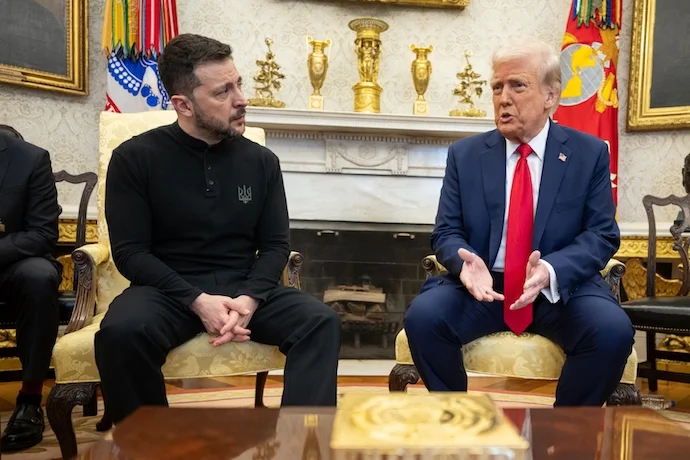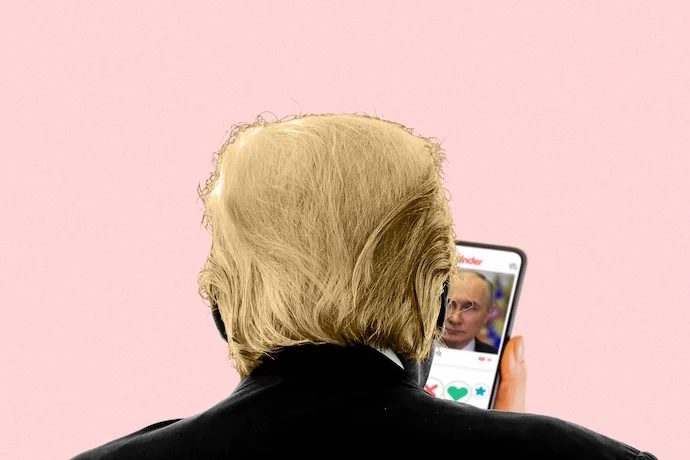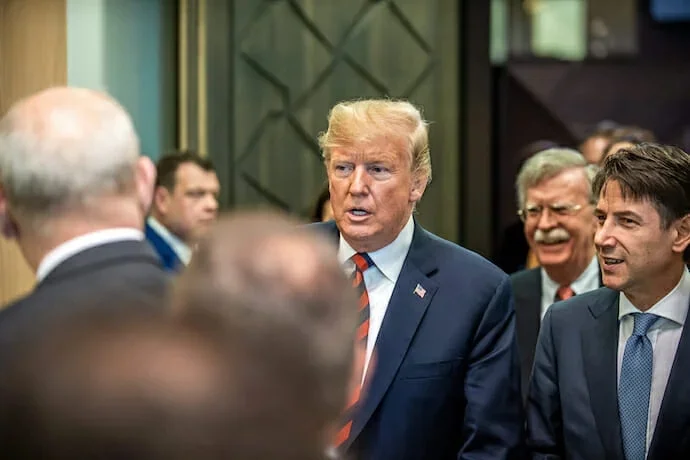
What Trump Gets Wrong About Russian Negotiation Tactics
On February 28th, in what amounted to a geopolitical dressing-down, President Donald Trump and Vice President J.D. Vance reprimanded Ukrainian President Volodymyr Zelensky in the Oval Office, attempting to assert authority over the embattled wartime leader. Eager to normalize Russian President Vladimir Putin’s place on the world stage and portray Russia as a potential “partner,” the Trump administration has wielded a far heavier hand with allies than it ever did with adversaries like China, North Korea, or Iran.
Currently, Trump is positioning himself as a would-be Nobel Peace Prize recipient by attempting to end the war in Ukraine while simultaneously seeking to extort Ukraine for mineral rights worth far more than any American military aid provided. What Washington’s increasingly kleptocratic leadership fails to grasp is that without firm security guarantees, Moscow will rearm and resume a far more devastating war.

Berating Zelensky
Although Zelensky had publicly congratulated Trump on winning the presidency the day after the November presidential election and expressed openness to working with the new administration, he has instead encountered aggressive, unconventional diplomatic tactics. By 2025, these methods had already ruptured relations with Canada, Mexico, Europe, and other allies.
A central focus of the Trump administration is “recouping” what it views as losses from wasteful government spending—Ukraine, in this framing, is now considered a liability. With this in mind, Washington is demanding hundreds of billions of dollars in mineral rights from Ukraine, ostensibly as interest on previous U.S. military aid—an amount that vastly exceeds the original defense allocations.
In Munich, Trump’s team attempted to force Zelensky into accepting a disproportionate mineral rights agreement. The Ukrainian delegation rejected the deal, citing a lack of time to properly review and evaluate it. In response, Zelensky returned to Washington with a revised proposal of his own, which the Trump administration interpreted as an affront.
Vice President Vance used the occasion to lecture Zelensky about the war and the mineral agreement. His comments, laced with distortions, could fairly be described as baiting. Notably, Vance had consistently voted against military aid to Ukraine during his brief Senate tenure. Zelensky, already under immense pressure from both Moscow and Washington, lost his composure—at which point Trump openly berated him on live television.
The summit quickly fell apart. No agreement was signed. Interpreting Zelensky’s defiance as a personal insult, Trump administration officials moved to indefinitely suspend future military assistance to Ukraine. They declared that no security guarantees would be forthcoming unless Trump’s version of a “peace deal” was finalized. The administration’s insistence on rehabilitating Vladimir Putin’s international standing—alongside Russia itself—has triggered alarm within NATO, as Trump’s views increasingly echo the Kremlin’s.

Abandoning Ukraine Plays Directly Into Moscow’s Hands
Trump’s current approach—leaving Ukraine without concrete security assurances—directly advances one of Moscow’s top strategic objectives. Absent a clear deterrent, Russia will rearm, regroup, and likely launch another full-scale offensive, as it has done in the past.
Like Russia, Ukraine faces a mounting demographic crisis, worsened by the continued threat of Russian aggression. Millions of Ukrainians have endured life under occupation, hundreds of thousands of children have been forcibly deported by Russian forces, and millions more have fled the country in fear of ongoing bombardments.
A ceasefire absent meaningful guarantees will not halt Russian bombs, nor will it encourage refugees to return to a country with no credible deterrent or sustainable economy—particularly when much of its industrial and natural resource base remains under occupation.
Russia’s Track Record: A History of Broken Promises
Accommodating Russia without maintaining the leverage currently held by the United States—including $300 billion in frozen Russian assets, the sanctions regime, and significant diplomatic influence—would amount to strategic capitulation. What makes Moscow especially dangerous is not only its military capacity but its consistent refusal to honor treaties or ceasefire agreements.
In the twilight years of the Russian Empire, countries like Estonia, Latvia, Lithuania, and Finland won their independence—acknowledged and codified by Moscow. But within two decades, the Soviet Union—led by Russia—invaded Finland and annexed the Baltic states, violating every prior treaty.
During the First Chechen War, Russia suffered massive casualties and formally recognized the Republic of Ichkeria’s sovereignty. Yet after the assassination of President Dzhokhar Dudayev, and amid suspicions of a false flag bombing in Ryazan, Russia initiated the Second Chechen War and forcibly reabsorbed the republic.
Following the collapse of the Soviet Union, Russia intervened on behalf of Abkhaz separatists in Georgia in 1992 and repeated the strategy in South Ossetia in 2008. Its involvement in Syria has been defined by brutal tactics, including the use of “double tap” bombings and support for the former Assad regime’s chemical warfare.
The failure of President Barack Obama to take a firm stance against these actions only emboldened Putin, who then trained his ambitions on Ukraine. The long-held Novorossiya project became a reality in 2014 with the annexation of Crimea and portions of Donbas. Rather than taking decisive action, the Obama administration issued lukewarm sanctions and downplayed Russia’s long-term threat to Ukraine and the broader European order.
Hopes for stronger deterrence under Trump and later Biden proved fleeting. Protracted talks simply bought Russia time to amass forces and logistics for the eventual full-scale invasion in February 2022. Repeated Western hesitation—particularly when faced with Russia’s nuclear saber-rattling—denied Ukraine the weaponry it needed to counter the onslaught. The result: total devastation in cities like Mariupol, Severodonetsk, Avdiivka, and Bakhmut.

A Frozen Conflict Ready to Boil Over
Trump’s rush to force a “peace deal” on Ukraine—without reciprocal pressure on Russia—threatens to reward aggression and enshrine territorial theft. Meanwhile, Russia continues its indiscriminate aerial bombardments even as it professes a desire for talks.
Having lost hundreds of thousands of troops, significant naval power in the Black Sea, and elite military units, the Kremlin now seeks a tactical pause. Yet, Russian officials have made clear their intent to meet all war aims—including capturing territories they do not currently control.
The broader goals remain the same: to landlock Ukraine, fulfill the Novorossiya project, and capture the rest of Zaporizhzhia, Kherson, Donetsk, Luhansk, and Kharkiv. They also aim to enforce permanent neutrality and demilitarization on Ukraine, effectively reducing it to a dependent vassal state, vulnerable to future invasions.
Ukraine’s demographics were already weakened by post-Soviet instability. The war has only made things worse. Without credible security guarantees, Russia could simply wait for Ukraine to collapse demographically or economically—or coerce a new government into submission.
If the West abandons Kyiv, Ukraine may turn to China, which supports Ukraine’s 1991 borders. Should Trump cede Ukrainian territory to Moscow, it could accelerate Beijing’s soft power expansion in Europe and further erode American influence and credibility.
A Dangerous Precedent
Trump’s approach—pressuring Ukraine to capitulate to both Washington and Moscow—will not avoid global conflict. It will heighten the risk of nuclear escalation. By turning contractual military aid and mutual defense into tools of extortion, the U.S. undermines its own treaties and alliances.
Ukraine relinquished its Soviet-era nuclear arsenal at Washington’s urging in exchange for guaranteed sovereignty. Now, faced with coercion from two nuclear powers, Kyiv and other nations may reconsider the value of nuclear deterrence. A new age of proliferation could follow.
The shockwaves would begin in Eastern Europe. Countries like Estonia, Latvia, Lithuania, Poland, and Romania—already in Moscow’s crosshairs—might pursue their own deterrents. Meanwhile, American inconsistency could embolden China and North Korea, prompting South Korea and Japan to rethink their reliance on U.S. guarantees.
A serious recalibration of U.S. policy toward Ukraine is urgently needed—one that prioritizes pressuring Russia and recognizes the necessity of robust, enforceable security commitments. History makes clear: Moscow has never honored a ceasefire it didn’t intend to break.
To force a previously disarmed nuclear state into a one-sided peace deal would send a dangerous global signal—that only weapons of mass destruction can secure sovereignty. The consequence may not be peace, but the reawakening of global nuclear proliferation.
